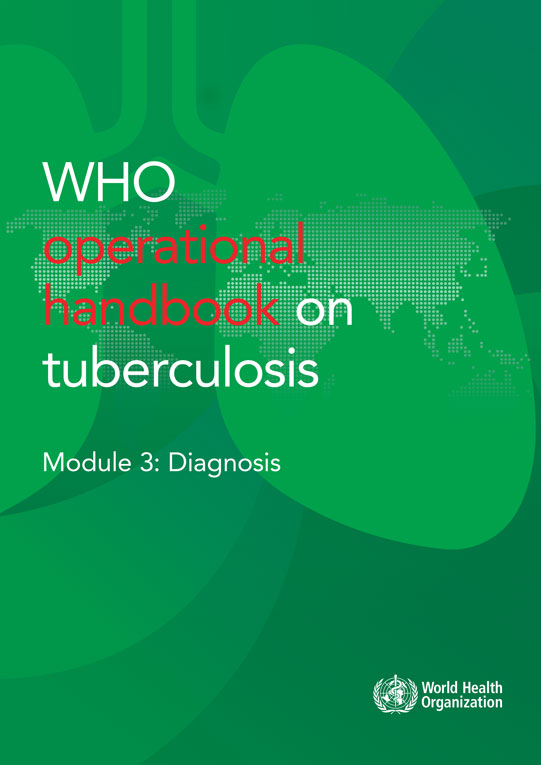Ruta de navegación
Module 3: Diagnosis
- Acknowledgements
- Abbreviations and acronyms
- 1. Introduction
- 2. TB tests with WHO recommendations
- 3. Strategies and considerations for diagnostic testing
- 4. Placement of diagnostic tests in the tiered laboratory network
- 5. Steps and processes for implementing a new diagnostic test
- 6. Model algorithms
- References⁷
- Annex 1. Budgetary considerations for implementing a new diagnostic test
- Annex 2. Drug susceptibility testing methods and critical concentrations
- Annex 3. Implementation of next-generation sequencing technologies
- Annex 4. Skin tests for tuberculosis infection – detailed description
- Web Annexes
Enlaces transversales de Book para 1266
Disclaimer: This text was not translated by WHO
Module 3: Diagnosis
Índice (versión en línea) :
- Acknowledgements
- Abbreviations and acronyms
- 1. Introduction
-
2. TB tests with WHO recommendations
- 2.1 Conventional tests for the diagnosis of TB
- 2.2 Initial tests for diagnosis of TB with drug resistance detection
- 2.3 Initial tests for diagnosis of TB without drug resistance detection
- 2.4 Follow-on diagnostic tests for detection of additional drug resistance
- 2.5 Phenotypic and genotypic drug resistance testing methods
- 2.6 Tests for TB infection
- 2.7 Tests WHO recommends against using or recommends limited usage
-
3. Strategies and considerations for diagnostic testing
- 3.1 Epidemiological considerations
- 3.2 Pretest probability and test accuracy considerations
- 3.3 Planning for and implementing quality-assured TB testing services
- 3.4 Concurrent testing to improve case detection in children and in people (of all ages) living with HIV
- 3.5 Testing for TB infection
- 3.6 Multidisease testing considerations
- 4. Placement of diagnostic tests in the tiered laboratory network
-
5. Steps and processes for implementing a new diagnostic test
- 5.1 Area 1 – Policies, budgeting and planning
- 5.2 Area 2 – Regulatory issues
- 5.3 Area 3 – Equipment
- 5.4 Area 4 – Supply chain
- 5.5 Area 5 – Procedures
- 5.6 Area 6 – Digital data
- 5.7 Area 7 – Quality assurance, control and assessment
- 5.8 Area 8 – Recording and reporting
- 5.9 Area 9 – Human resource training and competency assessment
- 5.10 Area 10 – Monitoring and evaluation
-
6. Model algorithms
- 6.1 Implementing a new diagnostic algorithm
- 6.2 The cascade of the four model algorithms
- 6.3 Algorithm 1 – WRDs as initial diagnostic tests for TB
- 6.4 Algorithm 2 – DST for second-line drugs for people with MDR/RR-TB
- 6.5 Algorithm 3 – Follow-on testing for individuals with RIF-susceptible TB at risk of resistance to other drugs
- 6.6 Discordant results
- 6.7 Algorithm 4 – Testing for TB infection
- 6.8 Illustrative algorithm combinations
- References⁷
- Annex 1. Budgetary considerations for implementing a new diagnostic test
- Annex 2. Drug susceptibility testing methods and critical concentrations
- Annex 3. Implementation of next-generation sequencing technologies
- Annex 4. Skin tests for tuberculosis infection – detailed description
- Web Annexes
Suggested citation. WHO operational handbook on tuberculosis. Module 3: diagnosis. Geneva: World Health Organization; 2025. Licence: CC BY-NC-SA 3.0 IGO.

 Reacción
Reacción